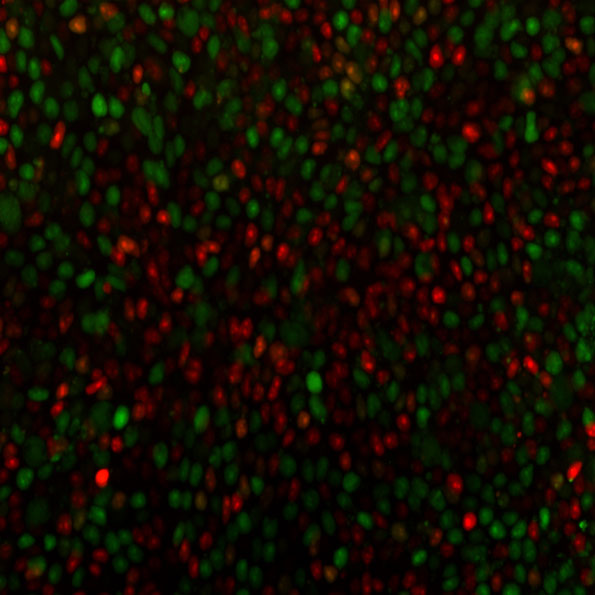Singapore scientists discover molecular cell cycle clock that controls stem cell potency

Human ESCs with fluorescence reporters aid the discovery of novel regulators of stem cell potency. Copyright : A*STAR
Singapore scientists from A*STAR’s Genome Institute of Singapore (GIS) have, for the first time, found further evidence of how the differentiation of pluripotent cells is tied to and controlled by the cell cycle clock. This deeper understanding of how cells become differentiated is extremely important when considering therapeutic potentials.
Embryonic stem cells (ESCs) are cells that have not differentiated into specific cell types, and are said to be in a pluripotent state. The cell cycle is divided into four phases: G1, S, G2 and M[1]. Previous studies have shown that cell differentiation of ESCs is initiated only in the G1 phase, attributed to G1-specific properties that contribute to lineage specification. The absence of these properties in the other three phases was believed to passively hinder differentiation.
This study, using high-throughput screening, provides the first evidence that during the S and G2 phases, the ESCs are more potent towards maintaining its stemness; that is, they actively resist differentiation.
Additionally, the scientists found that in instances of DNA damage, ESCs do not differentiate, so as to prevent the formation of specialised (differentiated) cells with compromised genomic integrity.
Findings from the study were published in the scientific journal Cell.
“Many studies have been devoted to looking at what keeps the ESCs in their undifferentiated state. Hence, to address a gap in the understanding of cell differentiation, our team at the GIS decided to focus on what regulates the ESCs’ exit from their pluripotent state,” said lead author of the research, Dr Kevin Gonzales, Post Doctoral Fellow at the Stem Cell and Regenerative Biology at GIS. “Moreover, most functional screens are carried out in mouse ESCs. The only functional screen on human ESCs was published in 2010 from our laboratory at the GIS. This latest study was also performed on human ESCs, making it more clinically relevant than studies using mouse ESCs.”
Co-lead author Research Fellow Dr Liang Hongqing at GIS’ Stem Cell and Regenerative Biology added, “Our research has shifted the current paradigm from a G1-phase centric view in stem cell regulation to a balanced view that different cell cycle phases perform different roles to orchestrate the stem cell fate.”
GIS Executive Director Prof Ng Huck Hui said, “Knowing that the S and G2 phases employ active pathways to prevent differentiation of ESCs, we can propose that, conversely, the absence of these pathways contributes to G1 phase amenability towards differentiation. This is truly an exciting and huge step forward in the study of cell pluripotency to advance fundamental understanding of human stem cells.”
[1] Cell cycle stages: (a) G1, first gap phase in preparation for DNA replication (G1); (b) S, DNA replication phase; (c) G2, second gap phase in preparation for cell division; (d) M, mitosis [cell division] phase.
Associated links
A*STAR press release
Media Contact
More Information:
http://www.researchsea.comAll latest news from the category: Life Sciences and Chemistry
Articles and reports from the Life Sciences and chemistry area deal with applied and basic research into modern biology, chemistry and human medicine.
Valuable information can be found on a range of life sciences fields including bacteriology, biochemistry, bionics, bioinformatics, biophysics, biotechnology, genetics, geobotany, human biology, marine biology, microbiology, molecular biology, cellular biology, zoology, bioinorganic chemistry, microchemistry and environmental chemistry.
Newest articles

Webb captures top of iconic horsehead nebula in unprecedented detail
NASA’s James Webb Space Telescope has captured the sharpest infrared images to date of a zoomed-in portion of one of the most distinctive objects in our skies, the Horsehead Nebula….

Cost-effective, high-capacity, and cyclable lithium-ion battery cathodes
Charge-recharge cycling of lithium-superrich iron oxide, a cost-effective and high-capacity cathode for new-generation lithium-ion batteries, can be greatly improved by doping with readily available mineral elements. The energy capacity and…

Novel genetic plant regeneration approach
…without the application of phytohormones. Researchers develop a novel plant regeneration approach by modulating the expression of genes that control plant cell differentiation. For ages now, plants have been the…





















